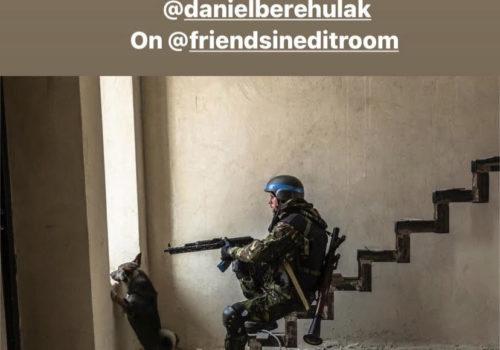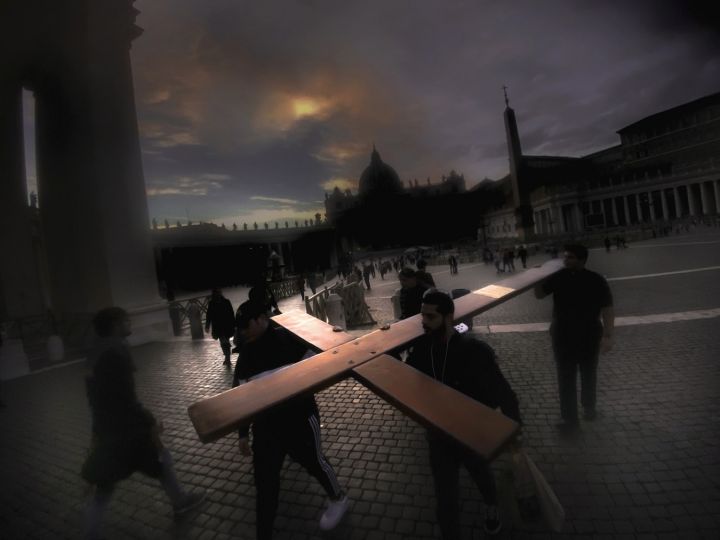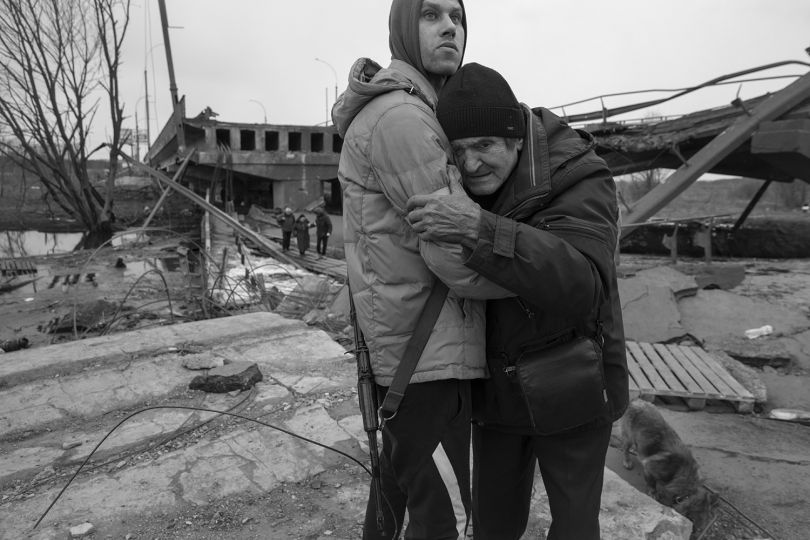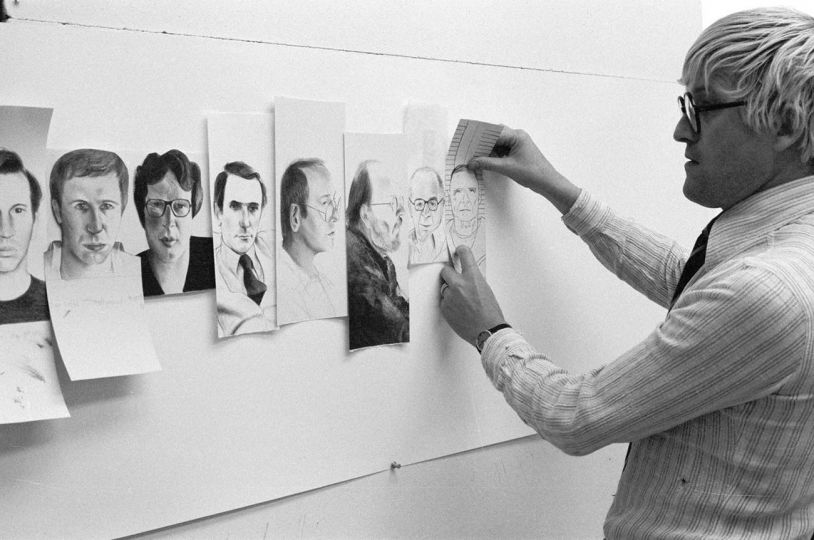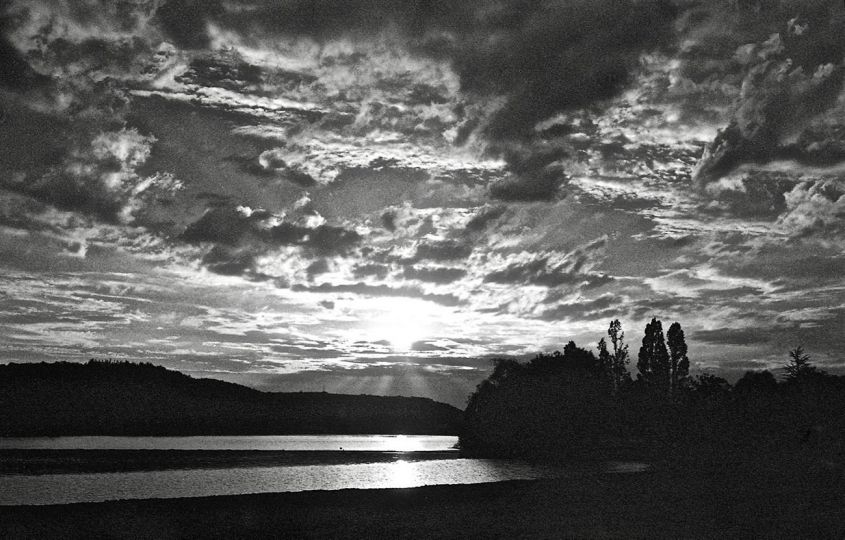Last week, journalist and cameraman Antonio Denti wrote to us about his Instagram project, Friends in Edit Room. The page gathers pictures of well-known and lesser-known photojournalists, reporters who went in the field to document the war in Ukraine, to bear witness to the daily life of civilians and troops, to show concrete, very real images, contrary to the official communication channels, military or aerial views.
Last week, we republished Laurence Haïm’s account of these photographers who left at their own expense, with little or no support from traditional newspapers. There are initiatives that make the work and the reality of this profession more visible, and oh so concrete. Thank you Antonio Denti.
“Hi Jean-Jacques, hi Arthur,
‘First of all, thank you very much for your interest in this Instagram project.
This project was born from an inner conflict. I am a shooter, having been a Reuters cameraman for over 20 years. I have covered conflict in Kosovo, Afghanistan, Iraq, Gaza and Israel, Lebanon etc and all kinds of major events. When the war in Ukraine started, on February 24, I felt a strong urge to go. At least, a big part of me did. It was history. But then I looked at my 8-years old son and I knew I would not go. At least for now. I am a father and he is just starting his life. So, staying behind in Rome, I found myself in the unusual position (for me) to sit and watch the work that my friends and colleagues were doing in Ukraine. Through Instagram, I soon realized that a great number of amazing photographers, within days, had traveled to cover the war.
This is the personal side on the way the idea was born. But there is a more general, profound, photographic, editorial reason. In the first days of the war I noticed that there was a big gap between the pictures I was seeing published in the media and the wealth of truly amazing work that I saw was being produced everyday in Ukraine and posted on Instagram by the photographers themselves. The idea was born as a way to fill this gap. For the first time I clearly saw that structured medias are an insufficient platform for visual journalism. There are many reasons why great pictures are taken but don’t make it to publication. The taste and skill of the photo-editors, the time and space constraints etc. In the case of the war in Ukraine I found the media useful mostly for commentary and analyses (The Atlantic, the Guardian, the NYT…) but not for the visual storytelling of the historical moment we are living. Instagram on the contrary came up as a great source for amazing photography, posted by the photographers themselves, from the field, bypassing the criteria of newsrooms far from the war.
So, I thought: it would be great to have a place on Instagram that gathers all this amazing, powerful, important photography that is being made everyday in Ukraine. One could watch in silence, without noise, commentary, breaking news alerts, advertisement, an attempt to visually capture and portray and report the essence and the truth, at least in part, of what is happening in Ukraine. It would be a bit of what the LIFE magazine was for photography. In our day.
I contacted a person I know that had initiated many photography hubs on Instagram, called the ”Friends” hubs. Some of them are very successful, with up to 200,000 followers – Friendsinperson, Friendsinbnw, Friendsinstreet, Friendsinprofile….. The Instagram hubs are a beautiful tool for photography: photographers submit their pictures with an hashtag and the hub’s editors choose, say, three a day to feature. They can focus on photography in general. street photography, black and white photography…I discovered some incredible photographers in the most diverse corners of the world through the Instagram hubs. Sometimes, photographers who are not published and I would never have known about.
I had hoped the person I contacted – a wizard of the hubs in my eyes – would welcome my idea to create one about the developing history happening in Ukraine and go on to establish it. Instead she told me that she could give me the keys of the smallest and less lucky of her hubs – Friendsineditroom – and gave me green light to try to make an experiment if I wished. I am a shooter – not an editor – and initially I resisted the idea of getting directly involved. But then, I thought that if I wanted to see a place like that – in the panorama of photojournalism and editorial, a place that I didn’t see yet – I could as well take responsibility and try to create it.
So, I did. The idea was to post one photographer a day. The first post was the work of Marcus Yam, the great photographer of the Los Angeles Times. And then I went on. My main (and only) rule is that I have to have the photographer’s direct and explicit permission to repost and what I repost must have been first published on the photographer’s Instagram account. If a photographer can authorise me personally, I’ll repost. If he/she doesn’t answer, I will not. If he/she tells me I need to contact his agency, I will simply not repost. This for me it is part of the ethos of the project. Friendsineditroom is a shooter to shooter ‘affair’. It doesn’t care about publishing first, publishing exclusively, publishing about the latest developments. On the contrary. Friendsineditroom posts pictures that have already had their ”real” life in the publishing world. Friendsineditroom is concerned with the most powerful photography that, in my opinion, captures part of the profound essence of what is happening. Photography that will stay. And put it all together, in one place.
And, in line with the feeling of brotherhood I’ve felt so many times with my colleagues in the field, as a shooter, as a foot-soldier of the media world, I am happy to value and emphasize the works of my colleagues when I like it. The pictures I post – in a way or another – are all pictures I would have liked to take. That’s why I am not interested in newsrooms, editors, agencies. In this case it is an homage to a shooter to fellow shooters, beyond rivalries, competition and agency divides.
It is quite extraordinary, I think, to have the pictures of great documentary photography like Ron Haviv, John Stanmeyer, Paul Hansen, Daniel Berehulak, Carol Guzy, Jan Grarup, Maxim Dondyuk, Valery Melnikov, Manu Brabo, Pavel Volkov ……next to top agency and news photographers like Marko Djurica, Thomas Peter, Vadim Ghirda, Bulent Kilic, Rodrigo Abd, Marcus Yam, Ronaldo Schemidt… next to less known (to me, at least) but extraordinary photographers like Albert Lores, Ugur Yildirim, Niklas Meltio, Alfredo Bosco …and Mstyslav Chernov who’s made the history of photojournalism with his coverage of the Mariupol siege. These are the photographers published in the first two weeks and there is much more to come. Such is the level of the photojournalism produced in Ukraine.
More or less, that’s it. This small hub provides an editorial treatment of the war’s storytelling which is an alternative to the structured media. It provides a place where great photojournalism can we watched in silence, with intensity and that it is there to stay…a bit like an encyclopedia, that will be watched in ten years. But timely produced as the war, unfortunately, is still going on.
And – for how this interests only me – it solved at least in part my inner conflict for not being in Ukraine. Too much of an important moment in history for me to be completely foreign to it.
I am not a fan of social media and Instagram is the only one I have. But in this case Instagram made this possible for me.
I think that’s it. Please reach out if you have more questions. I am very happy you are following.
Best regards, Antonio”
More informations:

